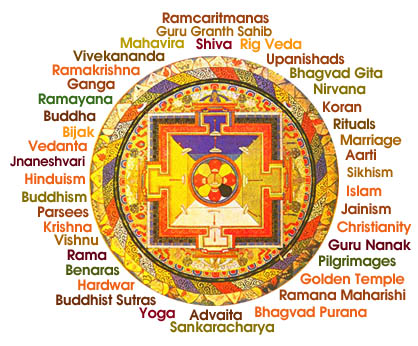 ince at least the eighteenth century, India has been associated in the European imagination as preeminently a land of religion. By the late nineteenth century, Europeans (and increasingly Americans) were coming to India as a landthat promised spiritual release from the weariness of the material life. In the twentieth century, this reputation appeared to be solidified. The struggle for independence came to be waged under the leadership of Gandhi, whose unflinching advocacy of non-violence endeared him to admirers as a man of religion and peace; and in the 1960s, when the enduring image of India was as a land suffused spirituality, Westerners flocked to India to avail themselves of the spiritual advice and teachings of countless number of Indian gurus. This image has taken something of a battering in recent years, and today Westerners, when they think at all of India, think of the country as engulfed by religious ‘wars’ and hatred, as ensnared by perpetual Hindu-Muslim conflict; meanwhile, the gross materialism of middle-class Indians, given naked encouragement by the state, indigenous and foreign corporate interests, the culture of modernity, and international finance organizations such as the IMF and the World Bank, has all but eroded the image as a land of sublime spirituality.
ince at least the eighteenth century, India has been associated in the European imagination as preeminently a land of religion. By the late nineteenth century, Europeans (and increasingly Americans) were coming to India as a landthat promised spiritual release from the weariness of the material life. In the twentieth century, this reputation appeared to be solidified. The struggle for independence came to be waged under the leadership of Gandhi, whose unflinching advocacy of non-violence endeared him to admirers as a man of religion and peace; and in the 1960s, when the enduring image of India was as a land suffused spirituality, Westerners flocked to India to avail themselves of the spiritual advice and teachings of countless number of Indian gurus. This image has taken something of a battering in recent years, and today Westerners, when they think at all of India, think of the country as engulfed by religious ‘wars’ and hatred, as ensnared by perpetual Hindu-Muslim conflict; meanwhile, the gross materialism of middle-class Indians, given naked encouragement by the state, indigenous and foreign corporate interests, the culture of modernity, and international finance organizations such as the IMF and the World Bank, has all but eroded the image as a land of sublime spirituality.
What is indubitably unique about India as a ‘land of religions’ is that it is the birthplace of several major world religions. Three-fourths of the people describe themselves as adherents of Hinduism, the oldest continuous faith in the world. Though today Hinduism has spread to all parts of the world, taken there by Indian migrants, Hinduism has, and will continue to have, an indelible association with India; and perhaps in no other case is the association between a faith and a land so close as it is with Hinduism. This religion produced a vast corpus of texts: preeminent among them have been the Rig Veda, the Upanishads, the Bhagavad Gita, the Ramayana, and the Bhagvata Purana; and the commentaries of Shankaracharya; modern-day classics include the Gospel of Sri Ramakrishna, the Gita-Rahasya of Tilak, and Conversations with Sri Ramana Maharishi.
India is equally a land of other faiths: the world’s second largest population of Muslims, nearly 130 million in number, is to be found in India, and there are also some 25 million Christians. Indian Islam has enjoyed a relationship that is at once syncretistic and agonistic with Hinduism, and the fruits of this encounter have been many, extending from the more obvious vocal and classical music of India, Mughlai cuisine, and Indo-Mughal architecture, to the lived practices common to adherents of both these great faiths. In antiquity, Buddhism flourished in India, and it is in Bodh Gaya that the Buddha gained enlightenment; his great contemporary, Mahavira, is the founder of Jainism, also uniquely Indian. Today Jains are among India’s most distinguished trading and business communities; and the legacy of Jain art and culture is just as profound. Sikhism, another Indian faith, is often imagined as the Protestantism of Hinduism: today there are nearly 15 million Sikhs in India, and perhaps as many as 2 million outside India, whose practices and precepts may well change the nature of the faith in India. India also has the largest community of Zoroastrians, also known as Parsees, and though in recent years the once-thriving and very old Jewish community of Cochin has all but disappeared, the small Jewish community of Bombay still makes its presence felt in the public realm.
But all these are only the institutionalized forms of religious worship in India, and a bewildering array of other religious practices, both outside the faiths and within the faiths, are encountered all over India. Various devotional poets, religious mendicants, renowned men and women of spirituality, and local holy men and women wear no religious tags, and their teachings and lives continue to be an example to the common realm of humanity. From the 9th century to the 16th century, from the Deccan to the north, and from Bengal in the east to modern-day Gujarat and Maharashtra in the West, India was swept by the fervor of bhakti, or devotion. The songs, lyrics, and religious compositions of the bhakti poets — Nammalvar,Jnaneshvar, Kabir, Tulsidas, Surdas, Tukaram, Vidyapati, Chandidasa, Mirabai, among others — are still sung to popular and classical music alike, and scarcely any kind of literature resonates more with Indians than do their compositions. Similarly, though the institutionalized religions are associated with great architectural monuments, such as the Hindu temple cities of South India (Kanchipuram, Rameswaram, Chidambaram, and many others), the Mughal splendors of Delhi, Agra, and Fatehpur Sikri, or the Golden Temple at Amritsar, the roadside monuments and shrines are even more indicative of the manner in which these faiths interweave with the lives of their adherents.



